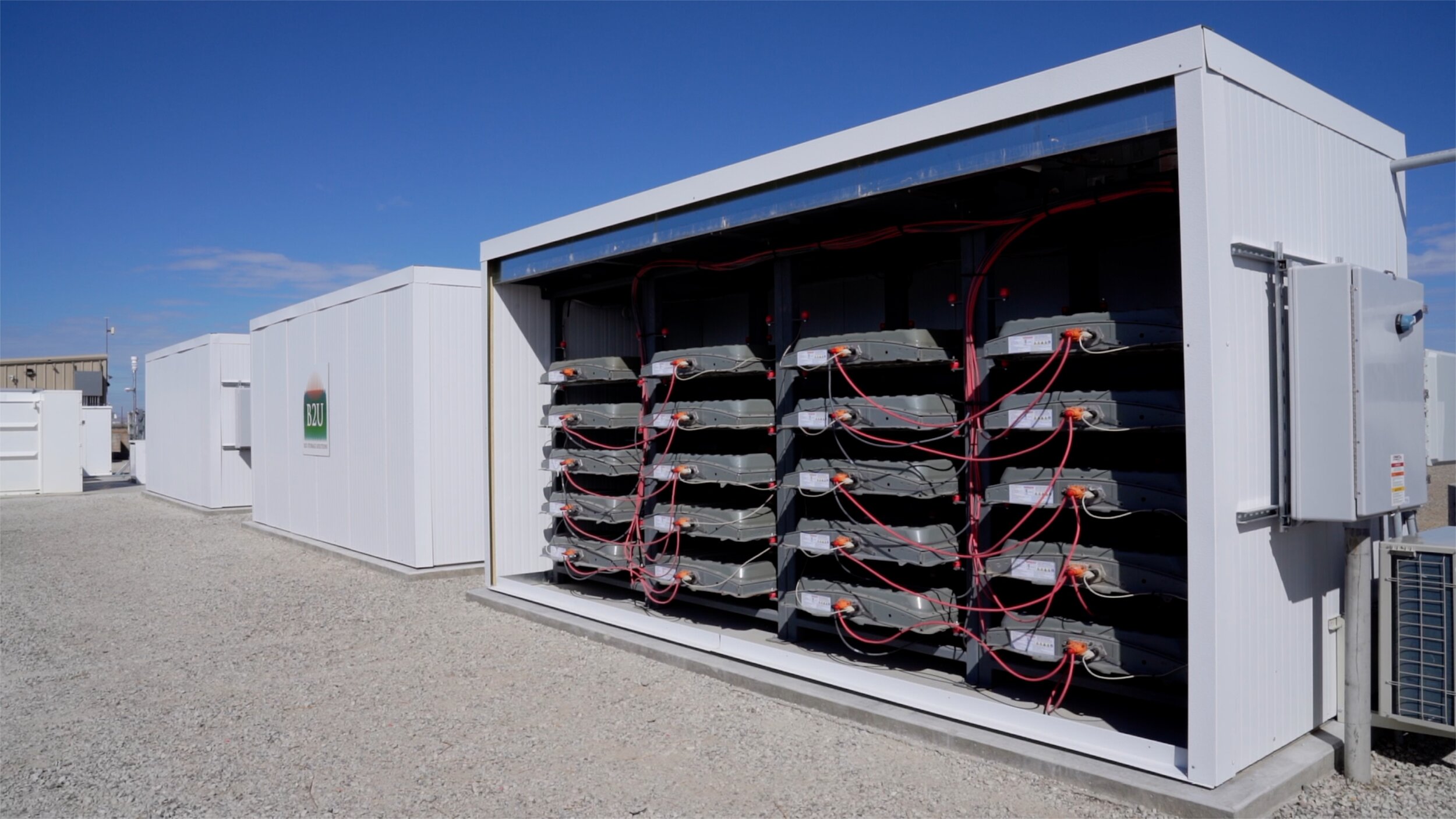- cross-posted to:
- [email protected]
- cross-posted to:
- [email protected]
This Southern California solar farm is using retired EV batteries for storing the power and then send to the grid when needed. This way the retired batteries can extend their usefulness for several…::A Southern California company is showing how repurposing EV batteries for stationary storage can extend their usefulness for several years.
That’s actually an ingenious idea I hadn’t thought about. How much cheaper are these batteries once they’ve been retired? Would this be a viable option for someone running solar at home, and wanting to store the power for later use, or is a home battery still the better option?
Yea, with a car you can’t really use them once the range gets low enough
With this, a bunch of batteries can work together for much longer. You also don’t need to worry about weight since they’re in one place
A Tesla Model 3, for example, has a battery capacity of 50 to 82 kWh. Let’s assume the lowest capacity of 50 kWh. A car battery is basically unusable long before it has lost around half its capacity. So 25 kWh. American households on average consume 10.6 MWh annually or about 29 kWh per day.
So an old Tesla battery still provides enough electricity to power an American household for nearly an entire day.
Really puts into perspective what a monumental waste of energy individual traffic, also with electric cars, is as well.
Well, sort of, it’s just that any sort of locomotion requires a lot more energy than you might think.
Yeah sure. But there’s a difference between moving a 2 ton vehicle per person or a bike.
There’s also something about their peak current being reduced with age, and in this use case, they don’t really need that peak current, so they really can stay useful for a long time in this use case
I thought I read that this was a plan Tesla had to repurpose the car batteries into power walls for home consumers. Not sure that ever ended up happening but great to see the retired car batteries given a second life
It’s the same cells inside both batteries. The difference is that the used EV car battery will store less power per volume since it’s worn out. It is a wonderful idea. A solar farm doesn’t care as much about volume and weight as a car does. For a home it would be fine as long as you’re trying to squeeze every inch cube of your property.
A 50 KWh or more battery pack will be overkill for most homes. But those will likely be available for cheap soon so it might still be a good option. Putting a pack that weighs several hundred kilos in your basement might be difficult, though.
I don’t know that a basement would be a good location regardless. If that thing sparks up, it’ll take out half the building before the fire department shows up.
I use mine as a box spring in my bedroom
Depends on the chemistry. I’d want NMC batteries outside and LFPs can be anywhere.
Im not 100% sure how the batteries are constructed from all of the cells (and I know it depends on the model), but the re-using process can work a lot better than just pulling out the battery and popping it down. EV batteries are in the range of hundreds of volts, but the cells themselves are about 4 volts. It’s my understanding that the battery as a whole doesn’t uniformly degrade, but you might have individual cells that degrade. If 1 cell in a chain of 10 goes bad, that chain can be made off limits to the battery, so you still technically have 9/10 cells that work fine.
The way a lot of people reuse/recycle/refurb (not sure what the right terminology is in this instance) EV batteries is to test each of the cells themselves, and get rid of the duds, and keep the decent cells. Tesla, for example, all used to use 18650 cells (and I think some models still do), which is the same exact cell that’s in decent name-brand cordless power tools.
When you aren’t required to keep weight, space, and extra circuitry to a minimum, you can really design a system that squeezes every last drop of usefulness out of those cells before they need to be melted down and remade.
I’m assuming that doing full charge/discharge cycles on them daily will put more wear on them than every day driving would?
But if your buying them at scrap value and the. Still selling them as scrap after a few more years I guess it works out.
The way lithium batteries work, they wear out less if you only discharge and charge them slightly. So a battery that is charged to 60%, discharged to 40%, and repeated like that will keep most of its capacity even after years of prolonged use. On the other hand, charging a battery quickly, until it is full, or discharging it until it is nearly empty will reduce its capacity over time.
A Tesla Model 3 has a battery capacity of at least 50 kWh. Even if it has lost half of its capacity, the 20% capacity difference between 60% and 40% charge, or more realistically, the 50% difference between 75% and 25%, still represents 12.5 kWh of capacity. Suppose you had an array of 1,000 such batteries. That would represent 12.5 MWh of storage capacity, enough to power ten thousand homes (at 1.2 kW each) for an hour. Certainly nothing to sneeze at.
This flies in the face of everything I thought I knew about charging my phone & laptop
Yea, back in the day, when first phones and laptops were coming out, the tech was different, and was better to fully discharge/charge the battery. Nowadays it’s the opposite, but the mith still survives
An easy analogy for batteries nowadays is to see them as an elastic completely relaxed at 50%. At 0% or 100% the elastic would be fully stretched. You want to avoid that to maximize its life
If you have an android there should be a “protect battery” mode that literally caps the charge at 85%
Thanks, I knew it was better to not fully charge lithium ion batteries, but I didn’t know Android had a setting for this. Just enabled it now.
I honestly thought once it got to 100% it stayed mains powered until unplugged to stop overcharging. Never realised 85% was optimal.
I think your right, its not going to keep cooking the battery. The problem is the battery doesn’t need to go over 85%. Your supposed to not let it go under 20 or over 85. Kind of hard to do.
The voltage of a Lipo corresponds to it’s charge level. So a Lipo at 4.2V (or in case of high voltage Lipos 4.35V) is full.
Up to ~80% of the charge, the lipo is charged by current limiting (basically, the voltage of the charging circuit raises so that it stays so much above the cell battery that it’s charging at a set current). This is the fast charging part of the charging process.
After the charging voltage reaches the maximum allowed cell voltage (4.2V/4.35V), the charging circuit cannot go above that voltage because it would risk overcharging and blowing up the cell. So the carging circuit holds the voltage at maximum level until the cell voltage catches up. Since the voltage difference shrinks with every bit of charge on the cell, so does the charging speed.
That’s why you only see “Charges the phone from 0-80% in X minutes” in the ads, and not 0-100%.
This means, that the charger in incapable of overcharging the phone.
But keeping the charger running even though it doesn’t charge the phone anymore wastes energy, so what they do once you reach 100% is that it will disable the charger until the voltage is down to 95%, when it will resume charging. That’s why it’s quite likely if you unplug the phone after charging overnight, that the battery is not at 100%, but slightly below.
The old rules applied to nickel batteries or whatever the last gen was called.
NiCd was the one with the bad memory effect that required full charging cycles. They where also really toxic which is why they are illegal in many countries now.
NiMh hardly had any memory effect left, but would degrade comparatively quickly.
Li-Ion/Li-Po is what we currently have. They don’t like to be full or empty for long times and like shallow charging cycles.
If you’re interested in more technical details on the topic, this site has tons of info.
I’ve seen some interesting use cases for EVs themselves as a form of energy storage. Not necessarily to discharge as a voltage regulation mechanism, but as a predictive load for evening daily swing.
as a predictive load for evening daily swing
What do you mean by that?
By daily swing I mean the difference between minimum (base load) and maximum (peak) MWh demand within a 24 hour window. Typically this means low period at night and high period in morning and late afternoon/evening. The types of generation and capabilities you have on the grid basically have to accommodate this demand swing while maintaining reliability. IE you can’t just run nuclear to provide for the peak because you can’t just turn it off when it’s not needed, stuff like that, voltage has to be regulated in real time to maintain the frequency of the grid.
With increasing transportation electrification people are largely charging their cars overnight, this is increasing the overnight demand and potentially raising the minimum base load and reducing the daily swing. This means you may not need as much capabilities to fill that gap, things like ramping up hydro (renewable but environmentally destructive) or gas (GHG emitting) to handle the swing and peaks. You can imagine if demand is always kept the same it would be much easier and more reliable so this is basically a way to get closer to that. Right now there’s a lot of tools like dispatchable generation, dispatchable loads, trading over interties to neighboring jurisdictions, load-shedding, and demand response programs where if large consumers alter their usage patterns in accordance with grid conditions they receive compensation.
Being packed away in a static location has much lower energy density requirements than driving around with the battery on-board. Getting the most out of them and then reprocessing the materials seems better than just reprocessing right away once they’re no longer useful for EVs.
Exactly, it goes from being about the capacity:weight ratio to capacity:cost and as a bonus also postpones having to use powernto recycle them (and hopefully it’ll be cheaper/more efficient to do so then).
In practice they’re used more as a sort of capacitor to provide voltage regulation on the grid, basically what gas is doing for reliability. Not sure how often that wouldn’t involve a full discharge, but I know most gas in this context is running way below its capability.
It sounds like this is being used for day/night storage here as opposed to spot demand, so it may be using more of the charge range.
I wonder if these batteries have reduced peak power output, can they fulfil the kind of balancing that you are suggesting? I guess if they had enough it would be fine.
I just assume so because of their application in EVs but might also depend what kv level lines they’re stepped up for.
So like… do electric car owners just need to buy new batteries? That’s the most expensive part!
Yeah, that’s the bit that makes me think there will be a shitload of people cut off from vehicle ownership by the electric revolution.
It’s time to end that stupid suburban sprawl, and make places walkable, cyclable, and have subsidised public transport. Because when the petrol age comes to an end, those people left out of the new one will revolt.
Sometimes, but not often. These are mostly 1st gen EV batteries, so they’re pretty old. It’s mentioned in the article that once capacity diminishes to the point of effecting range the old battery is replaced. Old units can be refurbished. These units could also be situations where the car surrounding the battery failed (accident, hail damage, etc) and they decided to scrap it and reclaim the battery.
At one time, they didn’t last more than a few years, and needed expensive replacement. Newer batteries have better BMS controllers on them and last a lot longer. But any damage pretty much necessitates replacement. The batteries can probably be fixed but IDK if they can be put back into use in vehicles then. So there’s plenty of used batteries that can be upgraded to use for stationary storage. You can buy them all day long on certain websites or auctions. It’s a pretty popular thing for DIY solar.
When they’ve reached end of life for the car, they are still useful.
EVs require high energy density so they get replaced when they don’t store enough energy for their weight. However for grid storage, weight doesn’t really matter (at least not as much) so a battery with 80% of its original capacity is a good (and cheap) solution.
When the market is mature, it will good for car owners who need to replace their batteries because the old one still has value.
Think of it like phone batteries, you dont, but overtime, the wear level of the battery is lower than new, and if that range is less than what you need to dailu drive, then people will get their battery swapped.
Its one of the reasons why car companies were hesitent to make lithium ion batteries for EVs
This should make it less expensive if EV owners can sell their old batteries to be turned into a grid battery.
The article mentions that they mostly use batteries from the Nissan Leaf and Honda Clarity. I’m not sure about the latter, but the Nissan Leaf does not have any kind of battery management system. That keeps the battery warm in winter and cool in summer, and helps it last a lot longer. Nearly every major EV on the market does this, but the Leaf is the big exception. It’s also the one car where you’ll see severe range degradation on an older model.
Sure… at roughly the same rate and/or lifespan as someone with a combustion powered car might need to rebuild their engine or transmission. It’s really not that big of a deal, and newer battery chemistries like the current LiFePO packs are continually getting longer and longer lived. BEV battery packs are already expected to last 10 to 20 years.
Engine swap is a few thousand. New battery full swap is close to 20k on a smaller car. Not quite the same.
What an atrociously dangerous planned design.
- Poor design: Thermal runaway is a serious problem that this setup has a very high chance of occurring. When it occurs, not if, it will spread fast from one container to the next and it will not be able to be put out that is the current fire fighting procedure for the state.
- It is very dangerous because these old batteries produce a very toxic and dangerous compounds when in thermal runaway. Again firefighting procedures cover hazmat requirements and it’s well documented the dangerous compounds that are present especially in these older batteries.
Net result. It will create another unstoppable fire that will dump poisons into ground water and the air recklessly endangering anyone down wind.
Solutions not problems:
- Isolate each container in an empty dam that is able to be filled with super chilled salt water the moment a runaway begins.
- Design fire suppression and shutdown to protect residents and the grid. Keep personal onsite to monitor with the authority to immediately react to fire incidents.
Do you think the engineers haven’t thought about that?
Do you think personal safety, firefighting ability, and effects on the environment has informed the design of like… anything in the last 50 years?
“Faster to catch fire, faster to spread, faster to catastrophically fail, more dangerous to life and health, and worse for the environment when it does so” describes anything from modern house construction to vehicle manufacturing.
Priority one is “cheaper”, the rest is just noise.
They actually have not thought of that no. In fact there is a cult like level of ignorance that has already just caused a serious fire & toxic release with this exact same hair brain layout and design. That said the method of fire containment is very new out of the Netherlands I believe.
After hearing jokes about college professors evacuating planes when they hear that their students designed them? Wouldn’t put it past em. Even experts make big mistakes.
This is a way to get off gas as it’s used for reliability and voltage regulation. There’s a few locations running pilots with different energy storage techs like this. One of the main problems with integrating renewables is they aren’t dispatchable generation so you’re basically throwing unknowns in to the system. This is mediated through programs like demand response and load following with gas, but the goal of decommissioning gas and fossils entirely while still providing reliability is hampered because of this gap in capability. Renewables paired with storage would accommodate more less flexible renewables and SMRs, and allow for more electrification of the economy with less climate impact. More electric arc furnaces!
Imagine that box there gets hit by lightning.
I mean, okay, but how much of anything can get hit by lightning and not be a smoldering crater without proper grounding and such?
One of my grandmothers great uncles.
Good idea but good luck to the people who will try to take the fire out
Edit: I’m not saying that it’s bad, of course renewable, solar, electric is good. But knowing how horrible electric vehicle fires are to put out, I don’t see a fire of piled up batteries being an easy challenge for firefighters
Any energy storage device has risks. In this case the risk is higher, but so is the overall energy storage capability. If you store them off to the side in their own little building, there’s no real risk beyond loss of investment and environmental impacts.
Not to mention, firefighters now have tools to fight these types of fires.
Also since it’s in one place, you can build in detection and fire suppression measures.
Could be as simple as having the tools nearby (fire hydrant style), or as complex as automating the checks and suppression (cut off power, isolate the problem cells, spray em)
If these batteries are stable (ie only needs maintenance rarely) , is there a reason not to keep them in a closed, CO2 filled enclosure?
Lithium batteries can produce oxygen when at high temperature. I’m not sure if they would produce enough to be able to start burning in such conditions, but I wouldn’t rule it out (maybe someone better versed in chemistry knows). And once they start burning, the fire heats them up more, so they produce more oxygen, whch further fuels the fire.
I wouldn’t be as worried about oxygen, but more worried about properly sealing the container off as a water leak could cause the lithium in the battery’s to produce hydrogen.
But the odds off either happening are very slim.
Edit: the water has to come in contact with the lithium.
That would be cool, maybe cost to keep the CO2 levels maintained and leak proof? I’d be curious to learn more about CO2 filled enclosures. I think some rare books are kept in them?
Another alternative could be to flood the room with CO2 when an issue is detected. But I guess that’s just fire suppression again
Batteries and by extension EVs have a much lower risk of catching fire than ICE cars. Stop repeating fossil fuel industry gaslighting.
Lower risk yes, but also harder to put out yes, and also the comparison here isn’t about cars at all.
It still shouldn’t be an issue as long as you place the storage somewhere where the fire can be contained easily, then worst case the whole storage burns down but there wouldn’t be significant collateral damage.
Bring on electric grid storage but don’t delude yourself it’s all sunshine and rainbows. The dangers of lithium nickel cobalt fires and toxic chemical release is very serious with a weird cult like level of ignorance. The actual grid battery fires and subsequent poisioning that’s occurred recently without consideration for the downwind population and groundwater are raising some big red flags.
Current state procedure for putting out lithium nickel cobalt fires. Hazmat gear and let it burn out.
Yeah, a huge tank of oil or natural gas or pile of coal is a total cake walk to extinguish! /s
For real.















